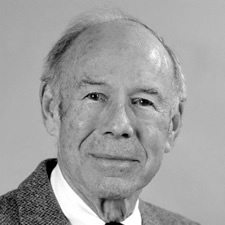

|

|
IN MEMORIAM
August Carl Helmholz
Professor of Physics, Emeritus
Berkeley
1915—2003
Professor August Carl Helmholz died of complications from pneumonia on October 29, 2003 at his home in Lafayette, California. Carl was a distinguished member of the University of California, Berkeley physics community for more than 65 years.
Carl was born on May 24, 1915 in Evanston, Illinois, and grew up for the most part in Rochester, Minnesota. He received his A.B. degree summa cum laude from Harvard University in 1936. After a year of study at the Cavendish Laboratory (Cambridge, England), he began graduate studies at Berkeley, receiving his Ph.D. under Edwin M. McMillan in 1940 with a thesis entitled, “The Energy and Spin Change in Nuclear Gamma Ray Transitions”. He was the 123rd student to receive a Ph.D. in physics at Berkeley. From 1940 to 1946, he served as an instructor and assistant professor in the Berkeley Department of Physics, and as a physicist in the Manhattan Project. He became associate professor of physics in 1948 and professor of physics in 1951. He served in a number of administrative positions, of which the most important was chair of the Berkeley Department of Physics from 1955 to 1962.
Carl’s work during the Second World War in the Manhattan Project was in the magnetic separation of uranium isotopes. His Ph.D. research in nuclear physics dealt with possible ways to determine the multipole order of various isomeric transitions. After the war, he continued his study of nuclear states produced by the bombardment of beams from Radiation Laboratory accelerators. This work culminated in 1949 with the publication (with E. Segrè) of what was, at the time, a definitive review of nuclear isomerism.
As with many of the nuclear physicists of the time, his interests naturally migrated to high-energy particle physics. While continuing isotope studies on the Berkeley campus, he worked with McMillan on the design and construction of the Berkeley 350 MeV electron synchrotron. A number of Berkeley students and visiting physicists used this accelerator to study both the production and properties of pions and muons. This effort was complementary to the work on the 184-inch cyclotron and was the beginning of accelerator-based research in particle physics. As accelerator energies increased, Carl turned his attention (with Burton J. Moyer) to the study of the pion-nucleon interaction. Results from these measurements were among the first signals of resonant behavior arising from the subatomic forces.
In total, Carl supervised 54 Ph.D. students. The names of these students read like a who’s who of the physicists of the last half of the twentieth century. It may well be that Carl’s greatest scientific impact was through the large number of his students who became distinguished researchers in their own right and then trained yet new generations of scientists.
Carl was an excellent and popular classroom teacher. Students in his courses found his lectures to be extremely well organized and presented clearly and with humor. He was a very humane man and showed a high degree of respect for students in his classes. Students never felt intimidated by him. He further contributed to education as an associate editor of the American Journal of Physics and by participating in numerous national committees dealing with education. With Moyer, he revised Volume 1 of the Berkeley Physics Course.
Some of Carl’s most important contributions came during his chairmanship of the Department of Physics. He was appointed to this position following Raymond T. Birge who had held the post for 23 years. Given that Carl had been promoted to professor just four years earlier, this was a very challenging responsibility, especially as his distinguished predecessor continued to occupy an office adjacent to the chairman’s office. Carl’s success over his seven years as chairman provides striking testimony to his diplomatic and administrative ability. This was a period of rapid growth in the department as it grew from about 30 to 50 tenured faculty. This growth was fueled by the rapid development of particle physics and condensed matter physics, and by the interest in space exploration. Many outstanding young physicists found a home in the Berkeley faculty, in particle physics, and in other emerging fields as well. Carl deserves much credit for this.
Carl’s service to the University of California extended outside the physics department. He was an active member of the Academic Senate, chairing many of its committees. During his tenure, he was usually a member of three or four Academic Senate committees every year. Even after his official retirement in 1980, he continued service on professional or Senate committees, and was a very active member of the Committee on University-Emeriti Relations.
A very significant contribution was made during his chairmanship of the Committee on University Welfare in the early 1950s when he worked to improve the faculty retirement system. This was the period during which the campus was recovering from the “oath controversy”. He was leader of a group that worked to transfer the faculty retirement system to the State Employees Retirement System (now called PERS). While this was not successful, it did result in the Regents establishing the current UC Retirement System.
Carl Helmholz will long be remembered at Berkeley and in the community of physicists for his scientific accomplishments, the enormous number of first-rate researchers who received Ph.D.s under his supervision, and his superb contributions to the administrative affairs of the Berkeley campus. On a more personal level, we shall remember the kindness, generosity, hospitality, and warmth unfailingly demonstrated by Carl and his wife Betty throughout the years.
Leroy Kerth
Howard Shugart
George Trilling